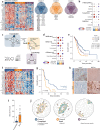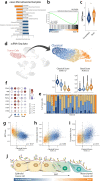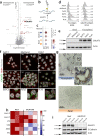Analysis of the glyco-code in pancreatic ductal adenocarcinoma identifies glycan-mediated immune regulatory circuits
- PMID: 35017635
- PMCID: PMC8752754
- DOI: 10.1038/s42003-021-02934-0
Analysis of the glyco-code in pancreatic ductal adenocarcinoma identifies glycan-mediated immune regulatory circuits
Abstract
Pancreatic ductal adenocarcinoma (PDAC) remains one of the most aggressive malignancies with a 5-year survival rate of only 9%. Despite the fact that changes in glycosylation patterns during tumour progression have been reported, no systematic approach has been conducted to evaluate its potential for patient stratification. By analysing publicly available transcriptomic data of patient samples and cell lines, we identified here two specific glycan profiles in PDAC that correlated with progression, clinical outcome and epithelial to mesenchymal transition (EMT) status. These different glycan profiles, confirmed by glycomics, can be distinguished by the expression of O-glycan fucosylated structures, present only in epithelial cells and regulated by the expression of GALNT3. Moreover, these fucosylated glycans can serve as ligands for DC-SIGN positive tumour-associated macrophages, modulating their activation and inducing the production of IL-10. Our results show mechanisms by which the glyco-code contributes to the tolerogenic microenvironment in PDAC.
© 2022. The Author(s).
Conflict of interest statement
The authors declare no competing interests.
Figures






References
-
- Rahib L, et al. Projecting cancer incidence and deaths to 2030: the unexpected burden of thyroid, liver, and pancreas cancers in the United States. Cancer Res. 2014;74:2913–2921. - PubMed
-
- Siegel RL, Miller KD, Jemal A. Cancer statistics, 2020. CA Cancer J. Clin. 2020;70:7–30. - PubMed
-
- Erkan M, et al. The role of stroma in pancreatic cancer: diagnostic and therapeutic implications. Nat. Rev. Gastroenterol. Hepatol. 2012;9:454–467. - PubMed
Publication types
MeSH terms
Substances
Grants and funding
LinkOut - more resources
Full Text Sources
Medical
Research Materials

